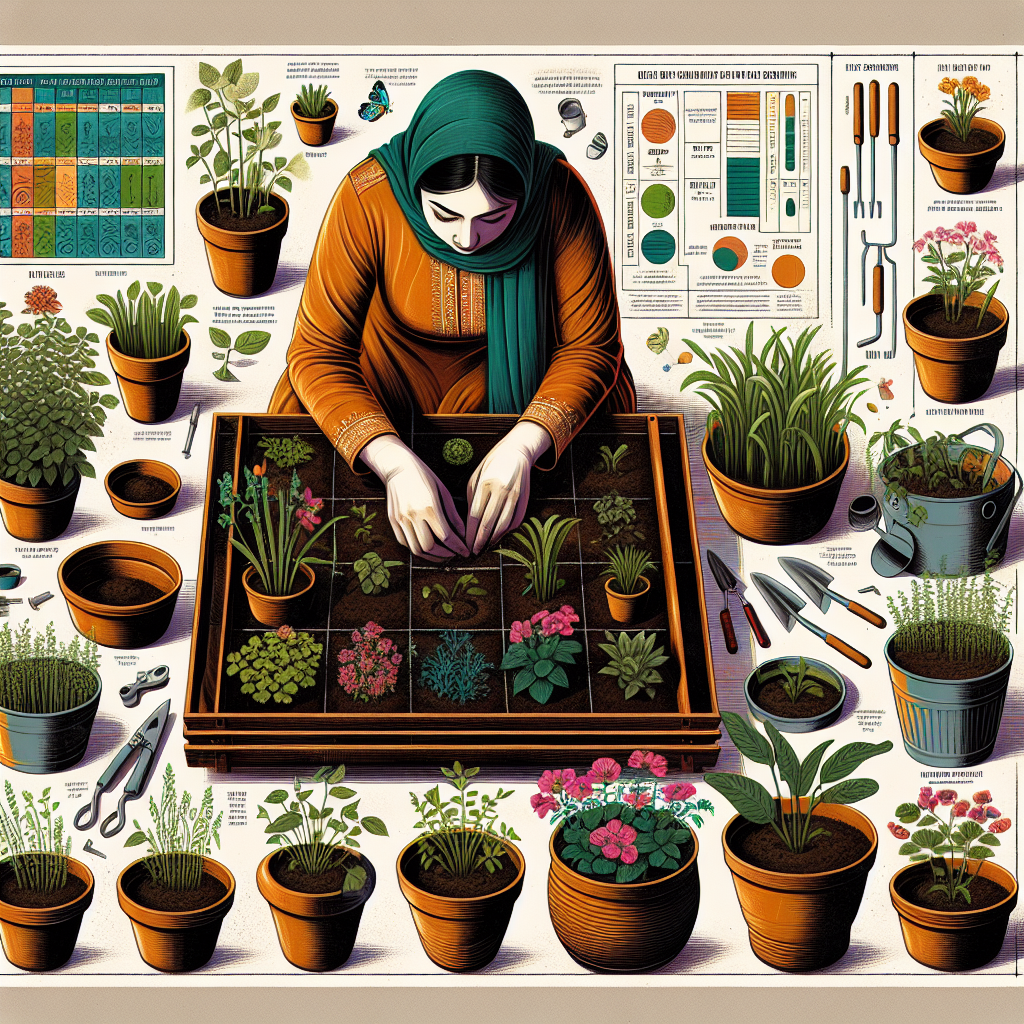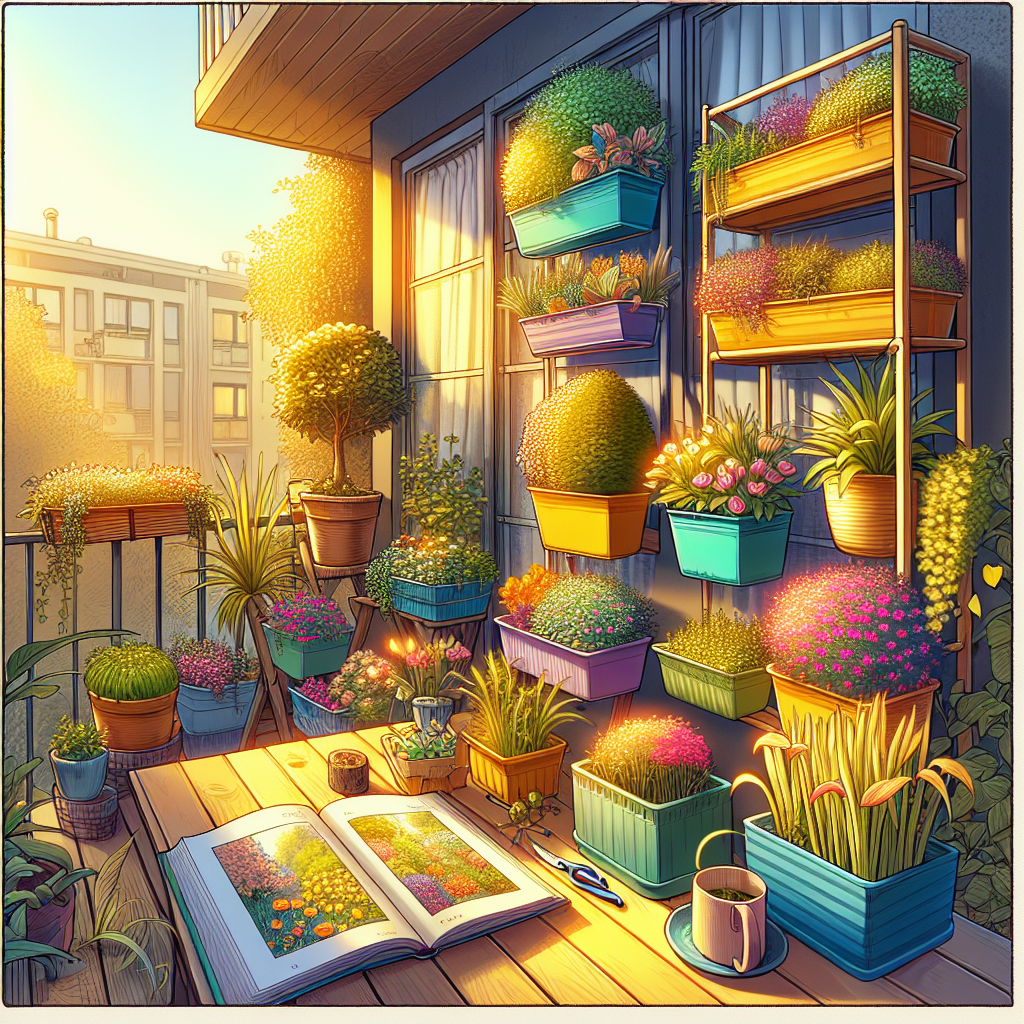Looking to add a touch of greenery to your space but don’t have a large garden? Look no further than container gardening! This article is packed with useful tips and tricks to help you achieve gardening success in limited spaces. From choosing the right containers to selecting suitable plants and providing proper care, you’ll find everything you need to know about creating a thriving mini garden right at your fingertips. So, grab your gardening gloves and get ready to embark on a rewarding journey of container gardening! Container gardening is a great way to add beauty and greenery to your outdoor space, no matter how big or small it may be. However, with so many choices available, it can be overwhelming to know where to start. That’s why we’re here to help! In this article, we will guide you through the process of choosing the right containers, selecting the right soil, picking the perfect plants, providing adequate sunlight, mastering watering techniques, feeding and fertilization, dealing with pests and diseases, pruning and maintenance, seasonal considerations, and even provide some creative container gardening ideas. So let’s dive in and get started!

Choosing the Right Containers
The first step in successful container gardening is selecting the right containers. When choosing containers, consider the size and depth. The size of the container should be proportional to the size of the plant you plan to grow. Additionally, consider the depth of the container. Deeper containers are ideal for plants with deep root systems, like tomatoes or peppers. However, shallow containers can be used for plants with smaller root systems, such as herbs or flowers.
Another important factor to consider is the drainage of the container. Good drainage is essential to prevent waterlogging and root rot. Look for containers with drainage holes at the bottom or opt for containers that come with saucers to catch excess water. This will ensure that your plants have the proper balance of water and oxygen.
In addition to size and drainage, think about the aesthetic appeal of the containers. Choose containers that complement your overall garden design and reflect your personal style. From traditional terracotta pots to modern stainless steel planters, there are countless options available to suit any taste.
Selecting the Right Soil
Once you’ve chosen the right containers, it’s time to think about the soil. Using high-quality potting mix is essential for the success of your container garden. Potting mix is specifically formulated to provide the right balance of nutrients, drainage, and moisture retention.
Consider adding perlite or vermiculite to the potting mix to improve drainage. These lightweight additives create air pockets in the soil, allowing excess water to drain away and preventing waterlogging.
Evaluating the pH level of the soil is also important. Most plants prefer slightly acidic to neutral soil, with a pH range of 6.0 to 7.0. Test the pH level of your potting mix using a soil testing kit, and adjust it if necessary by adding lime to raise the pH or sulfur to lower the pH.
Consider using compost or organic matter to enrich the potting mix. Adding compost improves soil structure and provides essential nutrients to your plants. Organic matter also helps retain moisture, reducing the frequency of watering.
Picking the Perfect Plants
Now that you have the right containers and soil, it’s time to choose the perfect plants for your container garden. When selecting plants, consider their suitability for containers. Look for plants labeled as “patio” or “container” varieties, as these are specifically bred to thrive in confined spaces.
Consider the size and growth habits of the plants you choose. Avoid selecting plants that will quickly outgrow their containers, as this can lead to cramped roots and stunted growth. Opt for compact or dwarf varieties that are better suited for container gardening.
It’s also important to combine plants with similar water and sunlight requirements in the same container. Some plants have higher water needs, while others prefer drier conditions. By grouping plants with similar needs together, you can ensure that all your plants thrive.
Another factor to consider is the seasonality of the plants. Some plants are more suited for cool seasons, while others prefer warm weather. Plan your container garden accordingly, and consider rotating plants based on the seasons to keep your garden looking fresh and vibrant year-round.
Providing Adequate Sunlight
Proper sunlight is crucial for the success of any garden, and container gardens are no exception. Place your containers in areas that receive the appropriate amount of sunlight for the plants you’re growing. While most plants need at least six hours of direct sunlight per day, some may require more or less depending on their specific needs.
Consider the sunlight requirements of different plants when positioning your containers. Group sun-loving plants together in full sun areas, while shade-loving plants should be placed in areas with partial shade.
In some cases, you may need to adjust the positioning of your containers to provide optimal sunlight exposure. Monitor the sun patterns in your garden throughout the day and move your containers accordingly. This will ensure that all your plants receive the right amount of sunlight for healthy growth.
If your garden lacks suitable sunlight conditions, you can use shade cloth or movable screens to create shade for shade-loving plants. This allows you to create microclimates within your garden and grow a wider variety of plants.

Watering Techniques
Knowing how to water your container garden is essential for its success. To water effectively, observe the moisture needs of your plants. Some plants prefer consistently moist soil, while others prefer it to dry out slightly between watering. You can learn these preferences by reading the care instructions that come with your plants or researching them online.
Check the moisture levels of the soil regularly by sticking your finger about an inch deep into the soil. If it feels dry at that depth, it’s time to water. If it still feels moist, hold off on watering for now.
When you water, make sure to do it deeply but infrequently. This encourages deeper root growth and helps your plants become more resilient to drought conditions.
Avoid overwatering and waterlogging, as this can lead to root rot and other diseases. It’s better to underwater slightly than to overwater, as most plants can recover from slight drought stress but struggle with excessive moisture.
Feeding and Fertilization
While potting mix provides some nutrients, your container plants will still benefit from regular feeding and fertilization. Choose appropriate fertilizers for container plants, as they have different nutrient requirements than plants grown in the ground.
Follow recommended fertilization schedules for your plants. Most plants benefit from regular applications of balanced fertilizers every two to four weeks during the growing season. Be sure to dilute the fertilizer according to the instructions and apply it to moist soil to prevent burning the roots.
Consider using slow-release fertilizers for convenience. These granules release nutrients slowly over time, providing a steady supply of nutrients for your plants.
Monitor your plants for nutrient deficiencies, such as yellowing leaves or stunted growth. Adjust your fertilization routine accordingly and consider using specific fertilizers formulated to address nutrient deficiencies.
Dealing with Pests and Diseases
Just like plants grown in the ground, container plants are susceptible to pests and diseases. However, there are steps you can take to prevent and address these issues.
Practice good sanitation and hygiene in your garden. Remove any dead plant material, fallen leaves, or debris from your containers regularly. This helps prevent the buildup of diseases and reduces the hiding places for pests.
Identify and address common container gardening pests. Aphids, mealybugs, and spider mites are some of the common pests that can affect container plants. Use organic insecticides or insecticidal soaps to control these pests. You can also introduce beneficial insects, such as ladybugs or lacewings, to naturally control pest populations.
Prevent diseases through proper watering and plant care. Avoid overwatering and waterlogging, as this creates a favorable environment for fungal diseases. Ensure good airflow around your containers to prevent the growth of mold or mildew. If necessary, prune or thin out your plants to improve air circulation.
Consider natural pest control methods, such as companion planting or using homemade insecticidal sprays. Some plants naturally repel pests, while others attract beneficial insects. By strategically planting these companions, you can create a healthier and more balanced ecosystem in your container garden.
Pruning and Maintenance
Regular pruning and maintenance are essential for the health and appearance of your container garden. Remove any dead or yellowing leaves as they can attract pests and diseases. Pruning also helps maintain the shape and control the growth of your plants.
Control weeds and undesired plant growth by regularly removing any unwanted plants from your containers. Weeds compete for nutrients and water, which can hinder the growth of your desired plants. Use a small hand tool or your hands to carefully remove weeds, taking care not to disturb the roots of your container plants.
Rejuvenate and repot plants as needed. Over time, plants can become root-bound or may outgrow their containers. If you notice stunted growth or roots circling the container, it’s time to repot. Choose a slightly larger container and refresh the potting mix when repotting to give your plants the space and nutrients they need to thrive.
Seasonal Considerations
As the seasons change, your container garden’s needs will change too. Prepare your containers for different seasons by taking weather conditions into account. In colder regions, protect your plants from extreme weather conditions by moving them indoors or providing them with frost protection, such as covering them with fleece or burlap.
Adjust your watering and feeding routines accordingly. During the summer months, your plants may need more frequent watering due to increased evaporation. In the winter, reduce watering to prevent waterlogging and root rot.
Consider overwintering techniques for perennial plants or plants that can survive the winter indoors. This involves providing them with proper care and protection during the colder months to ensure they survive and thrive in the following growing season.
Creative Container Gardening Ideas
Container gardening offers endless possibilities for creativity. Here are some ideas to inspire you:
Experiment with unusual containers, such as old buckets, wooden crates, or even colorful teapots. Upcycling everyday items can add a unique touch to your garden.
Combine colorful flowers and foliage to create eye-catching displays. Choose plants with complementary or contrasting colors to add visual interest and create a vibrant garden.
Create vertical gardens using trellises or hanging baskets. This is a great way to maximize space and grow more plants in a small area.
Grow herbs and vegetables in containers for a fresh and flavorful addition to your culinary adventures. Herbs like basil, thyme, and mint are particularly well-suited for containers and can be grown right on your kitchen windowsill.
With these tips and tricks, you’re well on your way to container gardening success. Start small and gradually expand your garden as you gain experience and confidence. Enjoy the beauty and bounty of your container garden, and don’t be afraid to get creative and try new things. Happy gardening!

